Effect of Structural Induced Stress on Creep of P92 Steel Pipe to Elbow Welds
Abstract
:1. Introduction
2. Finite Element Modeling
2.1. Welding Procedure and Material Properties
2.2. Finite Element Model
3. Results and Discussion
3.1. Effect of Structural Stress on Creep Stress
3.2. Effect of Structural Induced Stress on Creep of Pipe Inner and Outer Walls
4. Creep of a Pipe to Elbow Joint in an Ultra-Supercritical Boiler
5. Conclusions
- Compressive axial structural induced stress increases the stress on the pipe’s outer surface and reduces the stress on the inner surface, while the tensile structural induced stress has the opposite influence on the stress of pipe to elbow welds. Moreover, the effect of compressive structural induced stress is much higher than that of tensile structural induced stress.
- Compressive axial structural induced stress can significantly increase the creep strain near the pipe’s outer surface; at the same time, the creep strain near the pipe’s inner surface is decreased to some extent. Conversely, the creep strain near the inner surface is clearly accelerated by tensile axial structural induced stress. Meanwhile, the creep strain near the outer surface is mitigated to a certain degree. Compared with the free deformation condition in the pipe ends, at a compressive axial structural induced stress under −30 MPa, the equivalent creep strain in the FGHAZ at the 12:00 position on outer surface increases about 13.7 times, while, in the case of a 30 MPa tensile axial structural induced stress, the equivalent creep strain increases by about 83.3% in the FGHAZ at the 12:00 position on the interior surface.
- A clear difference in creep strain is found in different annular positions of the pipe to elbow weld due to the effect of structural induced stress. The creep strains in the FGHAZ at the 6:00 and 8:00 positions are nearly identical between the outer and inner surfaces of the weld. In contrast, the creep strain on the pipe’s inner surface is more significant than on the outer surface between the 8:00 and 10:00 positions and the creep strain on the pipe’s inner surface is smaller than on outer surface between the 10:00 to 12:00 positions.
- The maximum creep strain is 1.9% and located at the 10:30 position in the FGHAZ on the pipe’s outer surface, which makes it the weakest part of the welded joint. The location of a crack on a pipe after being in service for 20,000 h is in agreement with the simulation results.
Author Contributions
Funding
Data Availability Statement
Conflicts of Interest
References
- Li, J.F.; Gu, A.L.; Ma, Z.Y.; Zhang, C.L.; Sun, Z.Q. Economic Development, Energy Demand, and Carbon Emission Prospects of China’s Provinces During the 14th Five-Year Plan Period: Application of CMRCGE Model. Clim. Chang. Res. 2019, 10, 165. [Google Scholar] [CrossRef]
- Hao, J.; Gao, F.; Fang, X.; Nong, X.; Zhang, Y.; Hong, F. Multi-factor Decomposition and Multi-scenario Prediction Decoupling Analysis of China’s Carbon Emission Under Dual Carbon Goal. Sci. Total. Environ. 2022, 841, 156788. [Google Scholar] [CrossRef] [PubMed]
- Yang, K.; Zhang, Y.; Zhao, J. Elastoplastic Fracture Analysis of the P91 Steel Welded Joint under Repair Welding Thermal Shock Based on XFEM. Metals 2020, 10, 1285. [Google Scholar] [CrossRef]
- Tian, X.; Zhang, S.; Xu, H.; Li, T.; Yang, B.; Zhang, M. Assessment of Creep Properties Using Small Punch Test for a 9%Cr-Mo-Co-B Power Plant Steel. Metals 2021, 11, 1996. [Google Scholar] [CrossRef]
- Serindağ, H.T.; Tardu, C.; Kirçiçek, İ.Ö.; Çam, G. A Study on Microstructural and Mechanical Properties of Gas Tungsten Arc Welded Thick Cryogenic 9% Ni Alloy Steel Butt Joint. CIRP J. Manuf. Sci. Technol. 2022, 37, 1. [Google Scholar] [CrossRef]
- Ezer, M.A.; Çam, G. A Study on Microstructure and Mechanical Performance of Gas Metal Arc Welded AISI 304 L Joints. Mater. Werkst. 2022, 53, 1043. [Google Scholar] [CrossRef]
- Çam, G.; Koçak, M.; Santos, J.F. Developments in Laser Welding of Metallic Materials and Characterization of The Joints. Weld. World 1999, 43, 13. [Google Scholar]
- Santos, J.F.; Çam, G.; Torster, F.; Insfran, A.; Riekehr, S.; Ventzke, V.; Koçak, M. Properties of Power Beam Welded Steels, Al-and Ti-Alloys: Significance of Strength Mismatch. Weld. World 2000, 44, 42. [Google Scholar]
- Çam, G.; Erim, S.; Yeni, Ç.; Koçak, M. Determination of Mechanical and Fracture Properties of Laser Beam Welded Steel Joints. Weld. J. 1999, 78, 193. [Google Scholar]
- Adhithan, B.; Pandey, C. Study on Effect of Grain Refinement of P92 Steel Base Plate on Mechanical and Microstructural Features of the Welded Joint. Int. J. Pres. Ves. Pip. 2021, 192, 104426. [Google Scholar] [CrossRef]
- Sakthivel, T.; Sasikala, G.; Dash, M.K.; Syamala, R.P. Creep Deformation and Rupture Behavior of P92 Steel Weld Joint Fabricated by NG-TIG Welding Process. J. Mater. Eng. Perform. 2019, 28, 4364. [Google Scholar] [CrossRef]
- Xue, W.; Pan, Q.G.; Ren, Y.Y.; Shang, W.; Zeng, H.Q.; Liu, H. Microstructure and Type IV Cracking Behavior of HAZ in P92 Steel Weldment. Mat. Sci. Eng. A-Struct. 2012, 552, 493. [Google Scholar] [CrossRef]
- Pandey, C.; Kumar, N.; Sirohi, S.; Rajasekaran, T.; Kumar, S.; Kumar, P. Study on the Effect of the Grain Refinement on Mechanical Properties of the P92 Welded Joint. J. Mater. Eng. Perform. 2022, 31, 4385. [Google Scholar] [CrossRef]
- Zhang, W.; Wang, X.; Kang, Z.; Zhang, T.; Jiang, Y.; Zhang, X.; Gong, J. Characterization of the Cyclic Softening and Remaining Creep Behaviour of P92 Steel Weldment. J. Mater. Res. Technol. 2021, 15, 1446. [Google Scholar] [CrossRef]
- Meng, Q.; Wang, Z. Creep Damage Models and Their Applications for Crack Growth Analysis in Pipes: A Review. Eng. Fract. Mech. 2019, 205, 547. [Google Scholar] [CrossRef]
- Ennis, P.J.; Zielinska-Lipiec, A.; Wachter, O.; Czyrska-Filemonowicz, A. Microstructural Stability and Creep Rupture Strength of The Martensitic Steel P92 for Advanced Power Plant. Acta Mater. 1997, 45, 4901. [Google Scholar] [CrossRef]
- Xu, L.; Wen, J.F.; Tu, S.D. Numerical Simulations of Creep Damage and Crack Growth in P92 Steel Welded Joints. Trans. China Weld. Inst. 2019, 40, 80. [Google Scholar]
- Zhao, L.; Jing, H.; Xu, L.Y.; An, J.; Xiao, G. Numerical Investigation of Factors Affecting Creep Damage Accumulation in ASME P92 Steel Welded Joint. Mater. Des. 2012, 34, 566. [Google Scholar] [CrossRef]
- Chang, Y.; Xu, H.; Ni, Y.; Lan, X.; Li, H. The Effect of Multiaxial Stress State on Creep Behavior and Fracture Mechanism of P92 Steel. Mat. Sci. Eng. A-Struct. 2015, 636, 70. [Google Scholar] [CrossRef]
- El-Desoky, O.E.; Abd El-Azim, M.E.; EIKossy, M.R. Analysis of Creep Behavior of Welded Joints of P91 Steel at 600 °C. Int. J. Pres. Ves. Pip. 2019, 171, 145. [Google Scholar] [CrossRef]
- Zhao, L.; Jing, H.Y.; Xu, L.Y.; Han, Y.; Xiu, J.; Qiao, Y. Evaluating Creep Property of Distinct Zones in P92 Steel Welded Joint by Small Punch Creep Test. Mater. Des. 2013, 47, 677. [Google Scholar] [CrossRef]
- Kimura, K.; Sawada, K.; Kushima, H.; Kubo, K. Effect of Stress on The Creep Deformation of ASME Grade P92/T92 Steels. Int. J. Mat. Res. 2008, 99, 395. [Google Scholar] [CrossRef]
- Wang, X.; Pan, Q.G.; Liu, Z.J.; Liu, Z.J.; Zeng, H.Q.; Tao, Y.S. Creep Rupture Behaviour of P92 Steel Weldment. Eng. Fail. Anal. 2011, 18, 186. [Google Scholar]
- Wang, X.; Hu, L.; Xu, Q.; Chen, D.X.; Sun, S.T. Influence of Martensitic Transformation on Welding Residual Stress in Plates and Pipes. Sci. Technol. Weld. Join. 2017, 22, 505. [Google Scholar] [CrossRef]
- Radaj, D. Heat Effects of Welding: Temperature Field, Residual Stress, Distortion; Springer: New York, NY, USA, 2012. [Google Scholar]

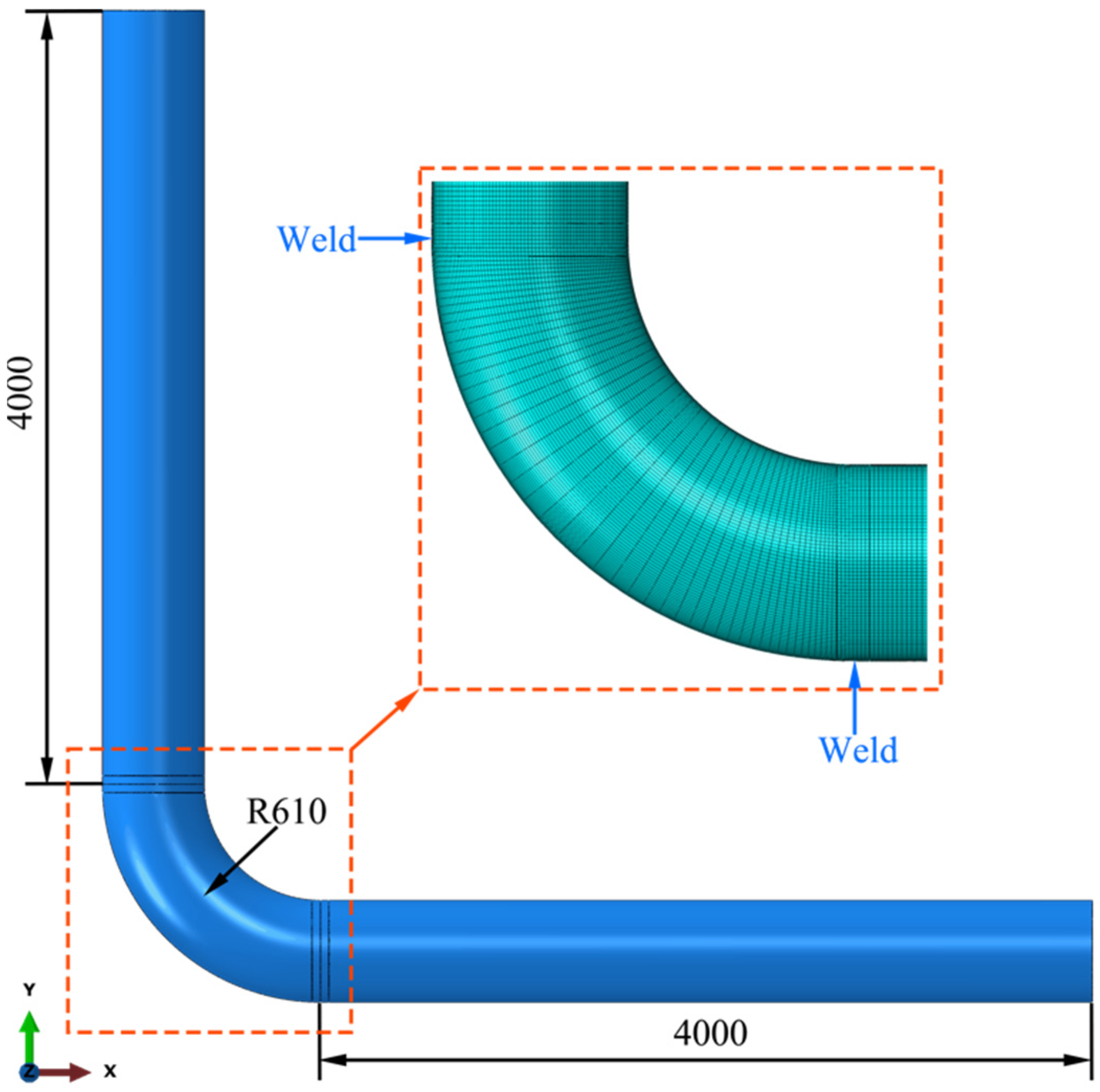

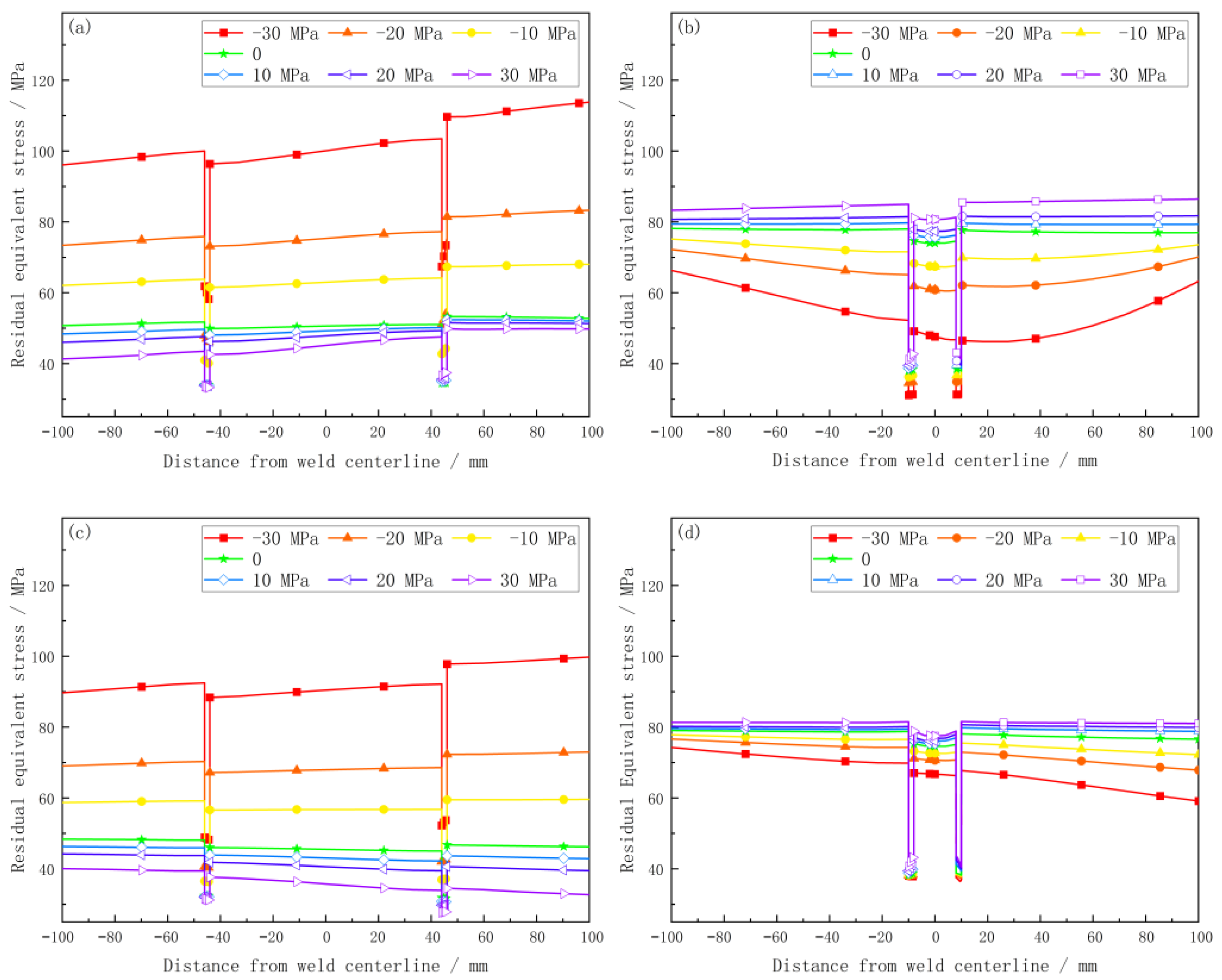
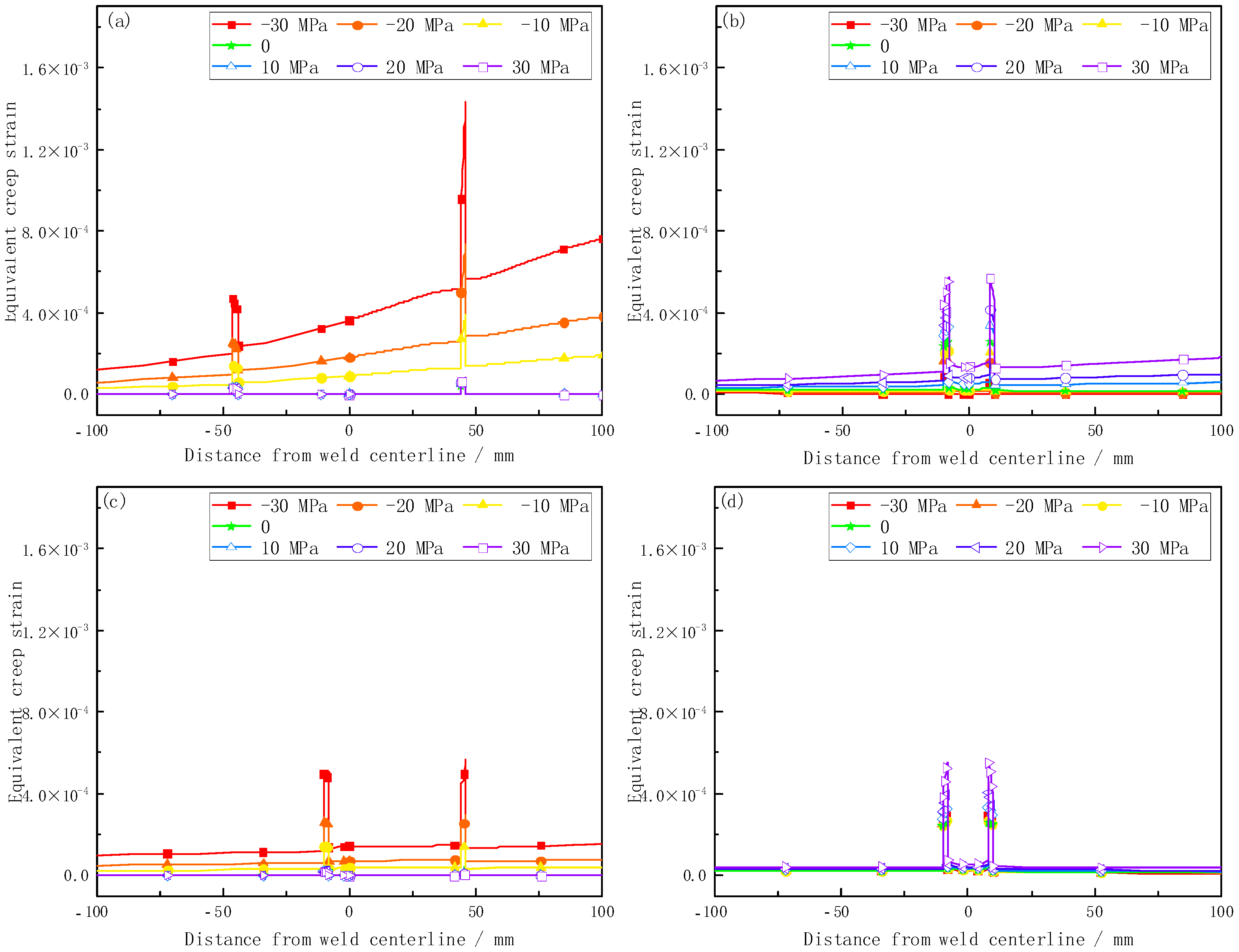

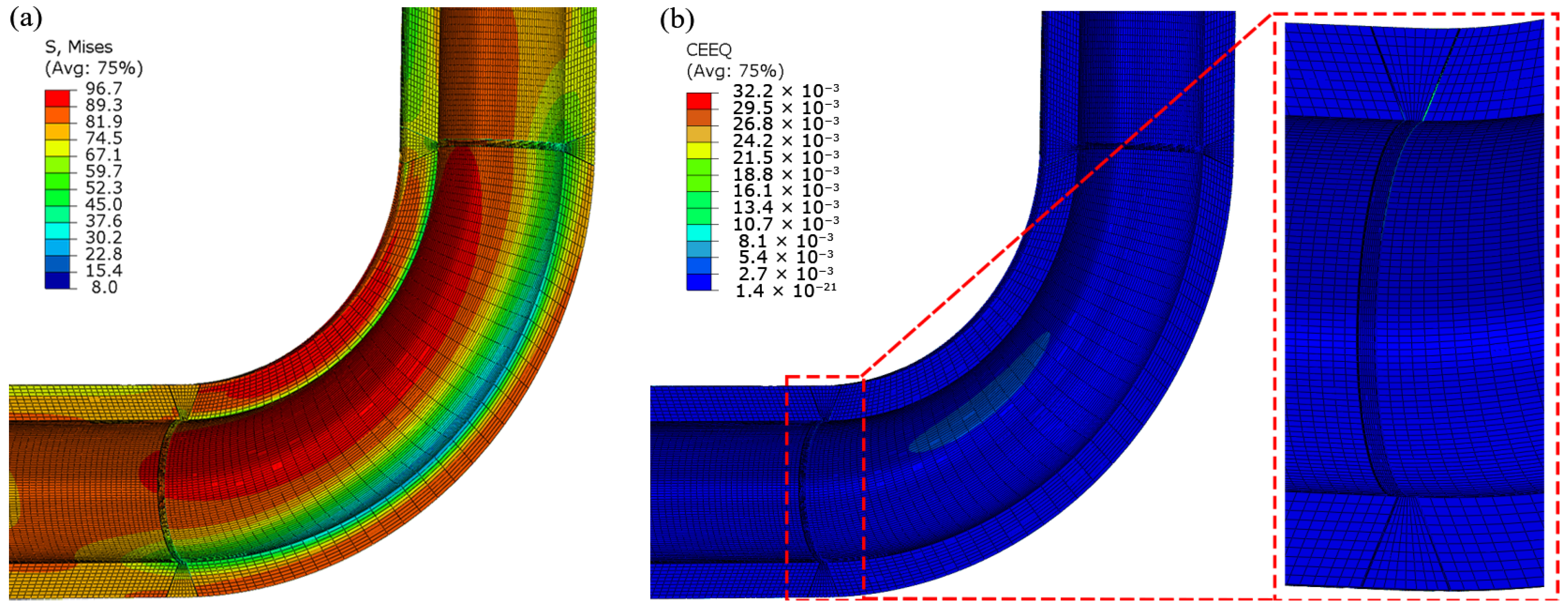
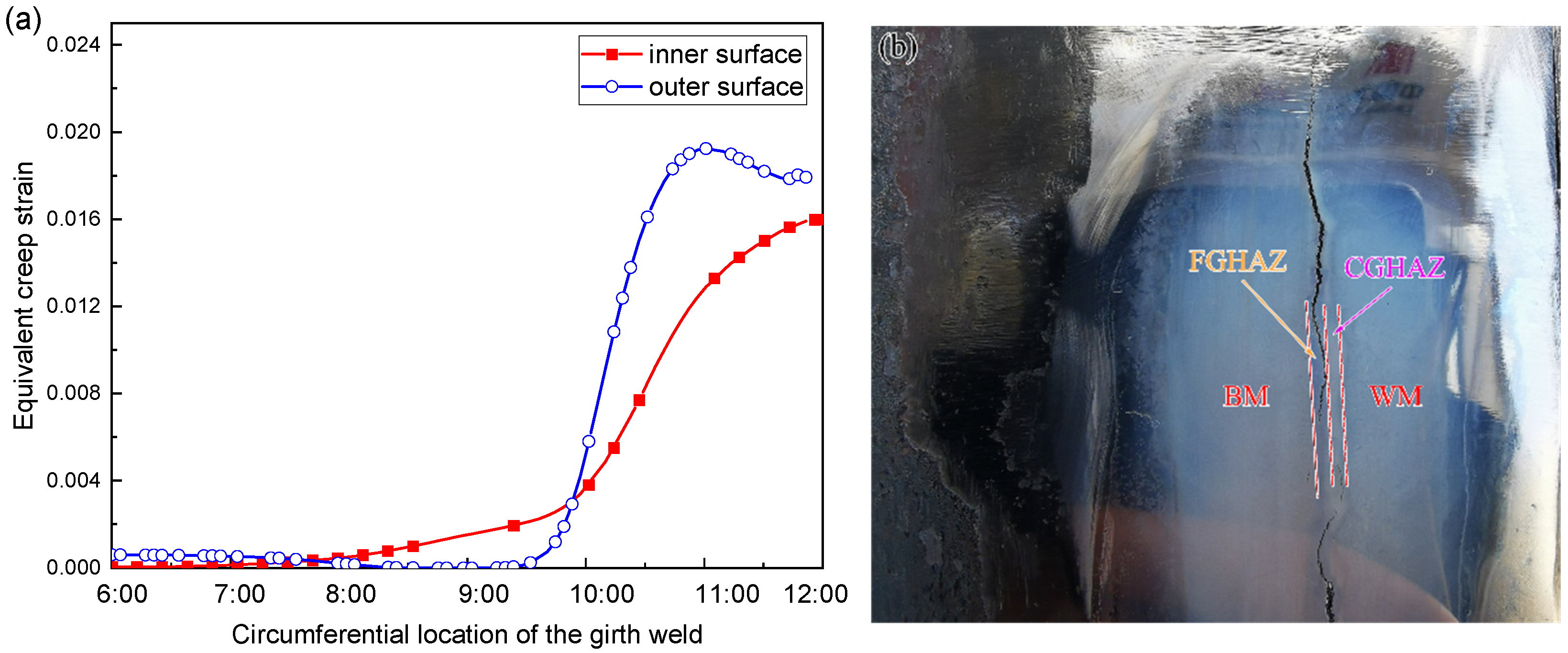
Publisher’s Note: MDPI stays neutral with regard to jurisdictional claims in published maps and institutional affiliations. |
© 2022 by the authors. Licensee MDPI, Basel, Switzerland. This article is an open access article distributed under the terms and conditions of the Creative Commons Attribution (CC BY) license (https://creativecommons.org/licenses/by/4.0/).
Share and Cite
Li, Y.; Hu, L.; Yan, J.; Ji, X.; Wang, W. Effect of Structural Induced Stress on Creep of P92 Steel Pipe to Elbow Welds. Metals 2022, 12, 1792. https://doi.org/10.3390/met12111792
Li Y, Hu L, Yan J, Ji X, Wang W. Effect of Structural Induced Stress on Creep of P92 Steel Pipe to Elbow Welds. Metals. 2022; 12(11):1792. https://doi.org/10.3390/met12111792
Chicago/Turabian StyleLi, Yong, Lei Hu, Jialing Yan, Xiangyu Ji, and Wanli Wang. 2022. "Effect of Structural Induced Stress on Creep of P92 Steel Pipe to Elbow Welds" Metals 12, no. 11: 1792. https://doi.org/10.3390/met12111792




